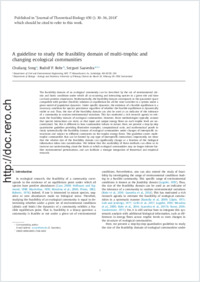A guideline to study the feasibility domain of multi-trophic and changing ecological communities
- Song, Chuliang Department of Civil and Environmental Engineering, MIT, Cambridge, USA
- Rohr, Rudolf P. Department of Biology - Ecology and Evolution, University of Fribourg, Switzerland
- Saavedra, Serguei Department of Civil and Environmental Engineering, MIT, Cambridge, USA
-
2018
Published in:
- Journal of Theoretical Biology. - 2018, vol. 450, p. 30–36
English
The feasibility domain of an ecological community can be described by the set of environmental abiotic and biotic conditions under which all co-occurring and interacting species in a given site and time can have positive abundances. Mathematically, the feasibility domain corresponds to the parameter space compatible with positive (feasible) solutions at equilibrium for all the state variables in a system under a given model of population dynamics. Under specific dynamics, the existence of a feasible equilibrium is a necessary condition for species persistence regardless of whether the feasible equilibrium is dynamically stable or not. Thus, the size of the feasibility domain can also be used as an indicator of the tolerance of a community to random environmental variations. This has motivated a rich research agenda to estimate the feasibility domain of ecological communities. However, these methodologies typically assume that species interactions are static, or that input and output energy flows on each trophic level are unconstrained. Yet, this is different to how communities behave in nature. Here, we present a step-by-step quantitative guideline providing illustrative examples, computational code, and mathematical proofs to study systematically the feasibility domain of ecological communities under changes of interspecific interactions and subject to different constraints on the trophic energy flows. This guideline covers multi-trophic communities that can be formed by any type of interspecific interactions. Importantly, we show that the relative size of the feasibility domain can significantly change as a function of the biological information taken into consideration. We believe that the availability of these methods can allow us to increase our understanding about the limits at which ecological communities may no longer tolerate further environmental perturbations, and can facilitate a stronger integration of theoretical and empirical research.
- Faculty
- Faculté des sciences et de médecine
- Department
- Département de Biologie
- Language
-
- English
- Classification
- Biological sciences
- License
-
License undefined
- Identifiers
-
- RERO DOC 322814
- DOI 10.1016/j.jtbi.2018.04.030
- Persistent URL
- https://folia.unifr.ch/unifr/documents/307441
Other files
Statistics
Document views: 128
File downloads:
- pdf: 378
- Supplementary material: 213

